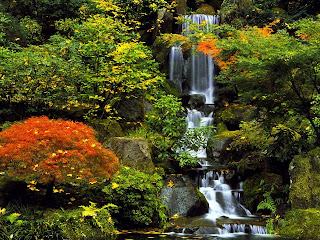Japanese gardens (日本庭園, nihon teien?), that is, gardens in traditional Japanese style, can be found at private homes, in neighborhood or city parks, and at historical landmarks such as Buddhist temples, Shinto shrines and old castles.
Some of the Japanese gardens most famous in the West, and within Japan as well, are dry gardens or rock gardens, karesansui. The tradition of the Tea masters has produced highly refined Japanese gardens of quite another style, evoking rural simplicity. In Japanese culture, garden-making is a high art, intimately related to the linked arts of calligraphy and ink painting. Since the end of the 19th century, Japanese gardens have also been adapted to Western settings.
Japanese gardens were developed under the influences of the distinctive and stylized Chinese gardens. One of the great interest for the historical development of the Japanese garden, bonseki, bonsai and related arts is the c. 1300 Zen monk Kokan Shiren and his rhymeprose essay Rhymeprose on a Miniature Landscape Garden.
The tradition of Japanese gardening was historically passed down from sensei to apprentice. In recent decades this has been supplemented by various trade schools. However, the opening words of Zōen's Illustrations for designing mountain, water and hillside field landscapes (1466) are "If you have not received the oral transmissions, you must not make gardens" and its closing admonition is "You must never show this writing to outsiders. You must keep it secret".
Typical features
A catalogue of features "typical" of the Japanese garden may be drawn up without inquiring deeply into the aesthetic underlying Japanese practice. Typical Japanese gardens have at their center a home from which the garden is viewed. In addition to residential architecture, depending on the archetype, Japanese gardens often contain several of these elements:
- Water, real or symbolic.
- Rocks or stone arrangements (or settings).
- A lantern, typically of stone.
- A teahouse or pavilion.
- An enclosure device such as a hedge, fence, or wall of traditional character.
- A bridge to the island, or stepping stones.
Traditional Styles:
Karesansui Gardens
Karesansui Gardens (枯山水) or "dry landscape” gardens were influenced mainly by Zen Buddhism and can be found at Zen temples of meditation (Japan Guide). Unlike other traditional gardens, there is no water present in Karesansui gardens. However, there is raked gravel or sand that simulates the feeling of water. The rocks/gravel used are chosen for their artistic shapes, and mosses as well as small shrubs are used to further garnish the Karesansui style (Japanese Lifestyle). All in all, the rocks and moss are used to represent ponds, islands, boats, seas, rivers, and mountains in an abstract way (Japan Guide). - Example: Ryōan-ji, temple in Kyoto, has a garden famous for representing this style. Daisen-in, created in 1513, is also particularly renowned.
Tsukiyama Gardens
Tsukiyama Gardens often copy famous landscapes from China or Japan, and they commonly strive to make a smaller garden appear more spacious (Japan Guide). This is accomplished by utilizing shrubs to block views of surrounding buildings, and the garden's structure usually tries to make onlookers focus on nearby mountains in the distance (Japanese Lifestyle). By doing this, it seems that the garden has the mountains as part of its grounds. Ponds, streams, hills, stones, trees, flowers, bridges, and paths are also used frequently in this style (Japan Guide).
Chaniwa Gardens
Chaniwa Gardens are built for holding tea ceremonies. There is usually a tea house where the ceremonies occur, and the styles of both the hut and garden are based on the simple concepts of the sado (Japan Guide). Usually, there are stepping stones leading to the tea house, stone lantern, and stone basins (tsukubai) where guests purify themselves before a ceremony(Japan Guide).
- Japanese gardens might also fall into one of these styles:
- Kanshoh-style gardens which are viewed from a residence.
- Pond gardens, for viewing from a boat.
Strolling gardens (kaiyū-shiki), for viewing a sequence of effects from a path which circumnavigates the garden. The 17th-century Katsura garden in Kyoto is a famous exemplar.



No comments:
Post a Comment